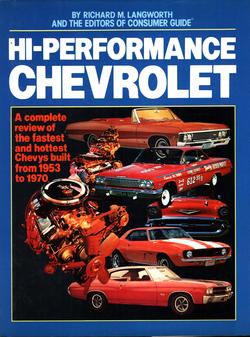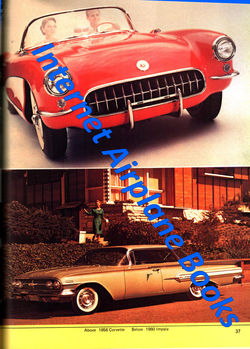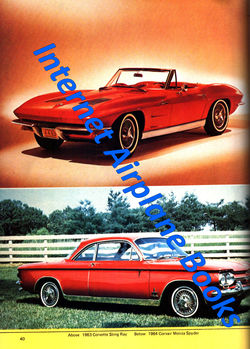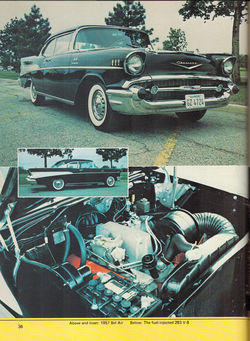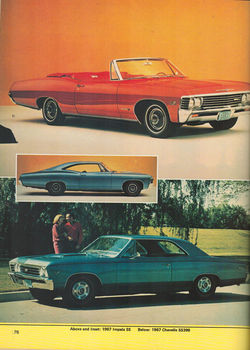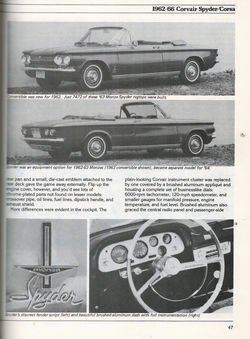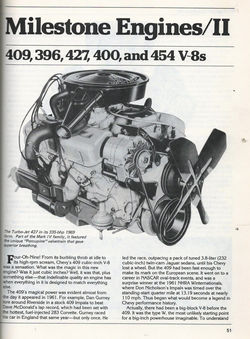HIGH-PERFORMANCE
CHEVROLETS HBDJ CORVAIR CORVETTE CAMARO IMPALA CHEVELLE NOVA MONTE CARLO 265
283 348 V-8 ENGINES 409 396 427 454 V-8 ENGINES SPYDER CORSA NOMAD BEL AIR
BEAUVILLE MALIBU
HARDBOUND BOOK in ENGLISH by RICHARD M. LANGWORTH
-----------------------------------------------------------------------------------------------------
Additional
Information from Internet Encyclopedia
The Chevrolet Corvair is a compact car
manufactured by Chevrolet for model years 1960�1969. It was the only
American-designed, mass-produced passenger car to use a rear-mounted,
air-cooled engine.
Corvair
models included a two-door coupe, convertible, four-door sedan, four-door
station wagon, passenger van, commercial van, and pickup truck variants.
Contemporary
competitors included the Volkswagen Beetle, Ford Falcon, Plymouth Valiant,
Studebaker Lark, and the Rambler American.
The
Corvair's reputation and legacy were impacted by a controversy surrounding its
handling: the car was scrutinized in Ralph Nader's 1965 book Unsafe at Any
Speed, GM's top management resorted to unethical measures in response to its
accusor, and a 1972 Texas A&M University safety commission report for the
National Highway Traffic Safety Administration found that the 1960�1963 Corvair
possessed no greater potential for loss of control in extreme situations than
its contemporaries.
The
name "Corvair" is a portmanteau of Corvette and Bel Air.[2] The name
was first applied in 1954 to a Corvette-based concept with a hardtop
fastback-styled roof that was part of the Motorama traveling exhibition.
During
1959 and 1960, the Big Three automakers planned to introduce their own
"compact" cars. Ford and Chrysler's designs were scaled-down versions
of the conventional American car, using four- or six-cylinder engines instead
of V8s, and with bodies about 20% smaller than their standard cars.
An
exception to this strategy was the Chevrolet Corvair. Led by General Manager
Cole, Chevrolet designed a new car deviating from the traditional American
norms of design. The car was powered by an air-cooled horizontally opposed
six-cylinder engine constructed with many major components made from aluminum.
The engine was mounted in the rear of the car, driving the rear wheels through
a compact transaxle. Suspension was independent at all four wheels. No
conventional chassis was used, being the first unibody built by Fisher Body.
The tires were an entirely new wide, low-profile design. The styling was
unconventional for Detroit: subtle and elegant, with no tailfins or chrome
grille. Its engineering earned numerous patents, while Time magazine put Ed
Cole and the Corvair on the cover, and Motor Trend named the Corvair as the
1960 "Car of the Year".
The
Corvair's sales exceeded 200,000 for each of its first six model years. The
rear-engine design offered packaging and economy advantages, providing the car
with a lower silhouette, flat passenger compartment floor, no need for power
assists, and improvements in ride quality, traction, and braking balance. The
design also attracted customers of other makes, primarily imports. The Corvair
stood out, with engineering significantly different from other American
offerings. It used GM's Z-body, with design and engineering that advanced the
rear-engine, rear-wheel drive layout pioneered by cars including the Tatra 77,
Tucker Torpedo, Fiat 500, Porsche 356, Volkswagen Beetle, Renault Dauphine,
Subaru 360, and NSU Prinz�and employed by the concurrent and short-lived Hino
Contessa.
The
Corvair's powerplant was an overhead-valve aluminum, air-cooled 140 cu in (2.3
L) flat-six (later enlarged, first to 145 and then to 164 cubic inches). The
first Corvair engine produced 80 hp (60 kW; 81 PS). Power peaked with the
1965�66 turbocharged 180 hp (134 kW; 182 PS) Corsa engine option. The first
generation model's swing axle rear suspension, invented and patented by
engineer Edmund Rumpler, offered a comfortable ride, but raised safety concerns
associated with the car's handling stability, and was replaced in 1965 with a
fully independent rear suspension similar to the Corvette Sting Ray.
The
Corvair represented several breakthroughs in design for mass-produced Detroit
vehicles, with 1,786,243 cars produced between 1960 and 1969.
The
1960 Corvair 569 and 769 series four-door sedans were conceived as economy cars
offering few amenities to keep the price competitive, with the 500 (standard
model) selling for under $2,000. Powered by the Turbo Air 6 engine 80 hp (60
kW; 81 PS) and three-speed manual or optional extra-cost two-speed Powerglide
automatic transmission, the Corvair was designed to have comparable
acceleration to the six-cylinder full-sized Chevrolet Biscayne. The Corvair's
unique design included the "Quadri-Flex" independent suspension and
"Unipack Power Team" of engine, transmission, and rear axle combined
into a single unit. Similar to designs of European cars such as Porsche,
Volkswagen, Mercedes-Benz, and others, "Quadri-Flex" used coil
springs at all four wheels with independent rear suspension arms incorporated
at the rear. Specially designed 6.5 by 13 in. four-ply tires mounted on 13 in
wheels with 5.5 in width were standard equipment. Available options included
RPO 360, the Powerglide two-speed automatic transmission ($146), RPO 118, a
gasoline heater ($74), RPO 119, an AM tube radio ($54), and by February 1960,
the rear folding seat (formerly $32) was standard. Chevrolet produced 47,683 of
the 569 model and 139,208 769 model deluxe sedans in 1960. In January 1960, two
two-door coupe models were introduced designated as the 527 and 727 models.
Following the success of the upmarket "Mr. and Mrs. Monza" styling
concept cars at the 1960 Chicago Auto Show, management approved the neatly
appointed bucket-seat DeLuxe trim of the 900 series Monza as a two-door club
coupe only. This model began arriving at showroom floors in April 1960. Despite
their late January introduction of the coupe, these cars sold well; about
14,628 base model 527 coupes, 36,562 727 deluxe coupes, and 11,926 927 Monza
club coupes, making the coupe one of the most popular Corvairs.
Sales
figures revealed to Chevrolet management that the Corvair was more of a
specialty car than a competitor to the conventionally designed Ford Falcon or
Chrysler's Valiant. Corvair was not as competitive in the economy segment.
Chevrolet began a design program that resulted in a compact car with a
conventional layout, the Chevy II, for the 1962 model year.[16]
An
available option on the Corvair introduced in February 1960 was RPO 649, a more
powerful engine, the "Super Turbo Air". Super Turbo Air was rated at
95 hp (71 kW; 96 PS) at 4,800 rpm and 125 ft-lb at 2,800 rpm due to a revised
camshaft, revised cylinder heads with dual springs, and a lower restriction
muffler with a 2" outlet. This option was available in any Corvair model.
However, in 1960, RPO 649 was not available with RPO 360, the Powerglide
automatic transmission.
The
advertised February introduction of a fully synchronized, four-speed
transmission RPO 651 was postponed until the 1961 model year. This was due to
casting problems with the aluminum three-speed transmission case which resulted
in technical service bulletins to dealers advising of the potential for
differential failure due to external leaks at the front of the transmission's
counter gear shaft. The revision of the four-speed transmission designated for
1961 introduction incorporated a cast-iron case and a redesign of the
differential pinion shaft to interface with a longer transmission output shaft
and a concentric pilot for the revised transmission case. These are among many
of the course corrections undertaken by Chevrolet by the end of the 1960 model
year.
In
1961, Chevrolet introduced the Monza upscale trim to the four-door sedans and
the club coupe body styles. With its newly introduced four-speed floor-mounted
transmission, DeLuxe vinyl bucket seats, and upscale trim, the Monza Club Coupe
gained in sales, as nearly 110,000 were produced along with 33,745 Monza
four-door sedans. The four-speed Monza caught the attention of the younger
market and was sometimes referred to as "the poor man's Porsche" in
various car magazines. The Monza series contributed to about half of the
Corvair sales in 1961.



